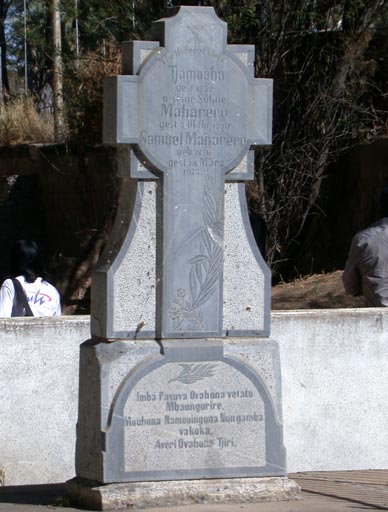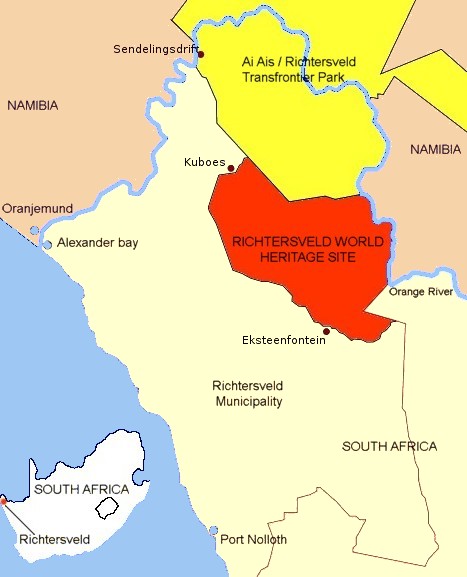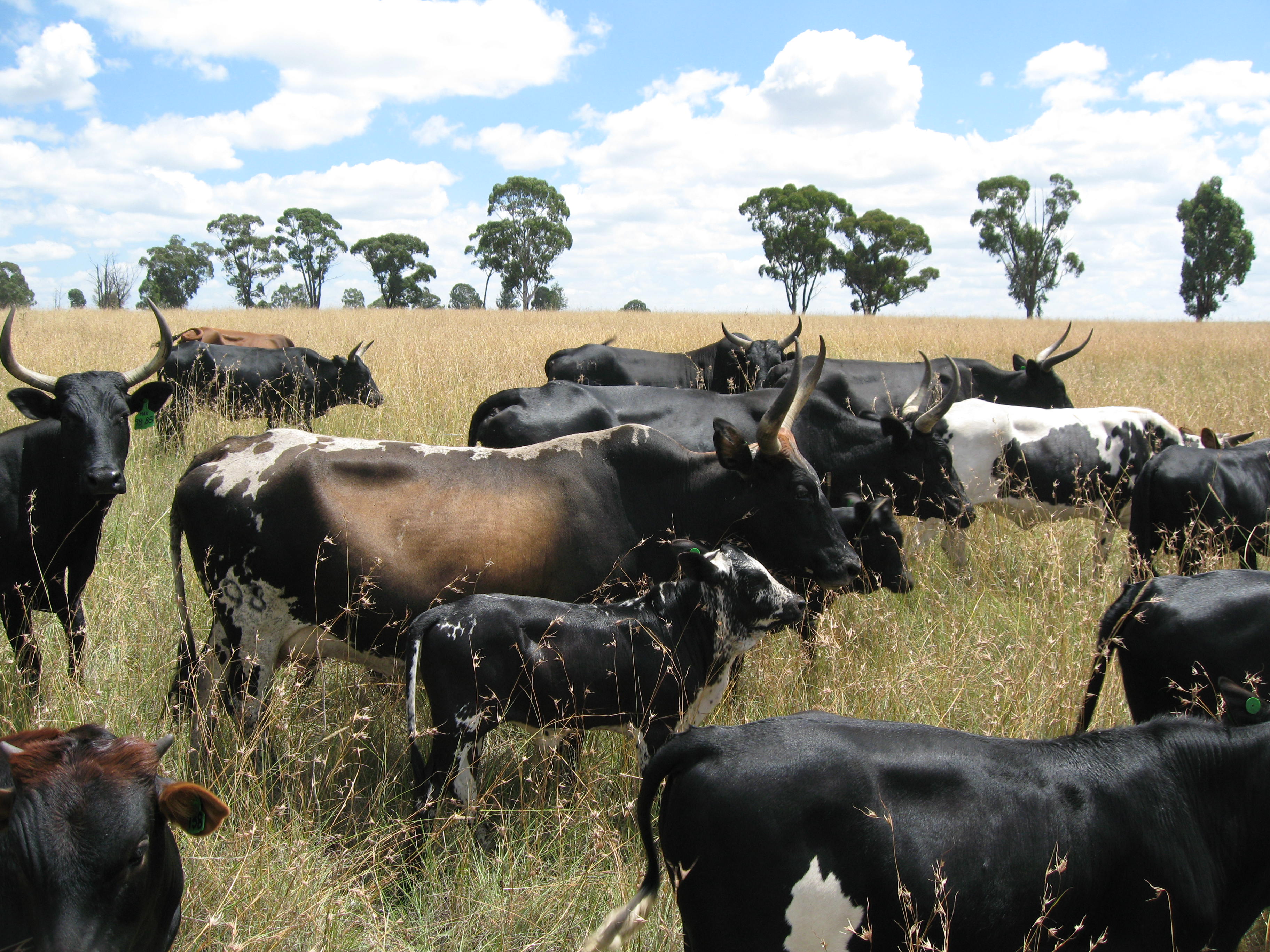|
Nama People
Nama (in older sources also called Namaqua) are an African ethnic group of South Africa, Namibia and Botswana. They traditionally speak the Nama language of the Khoe-Kwadi language family, although many Nama also speak Afrikaans. The Nama People (or Nama-Khoe people) are the largest group of the Khoikhoi people, most of whom have disappeared as a group, except for the Namas. Many of the Nama clans live in Central Namibia and the other smaller groups live in Namaqualand, which today straddles the Namibian border with South Africa. History For thousands of years, the Khoisan peoples of South Africa and southern Namibia maintained a nomadic life, the Khoikhoi as pastoralists and the San people as hunter-gatherers. The Nama are a Khoikhoi group. The Nama originally lived around the Orange River in southern Namibia and northern South Africa. The early colonialists referred to them as Hottentots. Their alternative historical name, "Namaqua", stems from the addition of the Khoekhoe ... [...More Info...] [...Related Items...] OR: [Wikipedia] [Google] [Baidu] |
Namibia
Namibia (, ), officially the Republic of Namibia, is a country in Southern Africa. Its western border is the Atlantic Ocean. It shares land borders with Zambia and Angola to the north, Botswana to the east and South Africa to the south and east. Although Kazungula, it does not border Zimbabwe, less than 200 metres (660 feet) of the Botswanan right bank of the Zambezi, Zambezi River separates the two countries. Namibia gained independence from South Africa on 21 March 1990, following the Namibian War of Independence. Its capital and largest city is Windhoek. Namibia is a member state of the United Nations (UN), the Southern African Development Community (SADC), the African Union (AU) and the Commonwealth of Nations. The driest country in sub-Saharan Africa, Namibia has been inhabited since pre-historic times by the San people, San, Damara people, Damara and Nama people. Around the 14th century, immigration, immigrating Bantu peoples arrived as part of the Bantu expansion. Since ... [...More Info...] [...Related Items...] OR: [Wikipedia] [Google] [Baidu] |
San People
The San peoples (also Saan), or Bushmen, are members of various Khoe, Tuu, or Kxʼa-speaking indigenous hunter-gatherer cultures that are the first cultures of Southern Africa, and whose territories span Botswana, Namibia, Angola, Zambia, Zimbabwe, Lesotho and South Africa. In 2017, Botswana was home to approximately 63,500 San people (roughly 2.8% of the population) making it the country with the highest number of San people. Definition The term "San" has a long vowel and is spelled Sān (in Khoekhoegowab orthography). It is a Khoekhoe exonym with the meaning of "foragers" and was often used in a derogatory manner to describe nomadic, foraging people. Based on observation of lifestyle, this term has been applied to speakers of three distinct language families living between the Okavango River in Botswana and Etosha National Park in northwestern Namibia, extending up into southern Angola; central peoples of most of Namibia and Botswana, extending into Zambia and Zimbabwe ... [...More Info...] [...Related Items...] OR: [Wikipedia] [Google] [Baidu] |
Maharero
Maharero kaTjamuaha (Otjiherero: ''Maharero, son of Tjamuaha'', short: Maharero; 1820 – 7 October 1890) was one of the most powerful paramount chiefs of the Herero people in South-West Africa, today's Namibia. Early life Maharero, was born about 1820 at Okahandja. In 1843 he went with his father Tjamuaha to Windhoek to stay with Jonker Afrikaner, Captain of the Oorlam Afrikaners. Tjamuaha was an ally of Jonker Afrikaner until his death in 1861, albeit in a subordinate position. Maharero a leader of Ovaherero community in (1861-1890) was born in ca 1820 at Otjikune near Okahandja and he was the son of Tjamuaha and his chief wife Tjorozumo. He had several brothers and half-brothers, amongst them were Kavezeri, Kariteova, Kavikunua and Rijarua. Like his father, Maharero became an ally of Jonker Afrikaner in 1843. As from 1863 onwards, he refused to accept the dominance of the Afrikaners and was recognized by both Herero’s and the European in the country as the representat ... [...More Info...] [...Related Items...] OR: [Wikipedia] [Google] [Baidu] |
Damaraland
Damaraland was a name given to the north-central part of what later became Namibia, inhabited by the Damara (people), Damaras. It was bounded roughly by Ovamboland in the north, the Namib Desert in the west, the Kalahari Desert in the east, and Windhoek in the south. In the 1970s the name Damaraland was revived for a bantustan in South West Africa (present-day Namibia), intended by the apartheid government to be a self-governing homeland for the Damara people. A centrally administered local government was created in 1980. The bantustan Damaraland was situated on the western edge of the territory that had been known as Damaraland in the 19th century. Damaraland, like other homelands in South West Africa, was abolished in May 1989 at the start of the Namibian War of Independence, transition to independence. The name Damaraland predates South African control of Namibia, and was described as "the central portion of German South West Africa" in the Encyclopædia Britannica Eleven ... [...More Info...] [...Related Items...] OR: [Wikipedia] [Google] [Baidu] |
Rhenish Missionary Society
The Rhenish Missionary Society (''Rhenish'' of the river Rhine) was one of the largest Protestant missionary societies in Germany. Formed from smaller missions founded as far back as 1799, the Society was amalgamated on 23 September 1828, and its first missionaries were ordained and sent off to South Africa by the end of the year. The London Missionary Society was already active in the area, and a closer working relationship was formed with them. The Society established its first mission station in the Cederberg in 1829, named Wupperthal, and predated the naming of the German city by 100 years. Very soon, the missionaries started migrating north through the barren and inhospitable south-western Africa. Here they encountered various local tribes such as the Herero, Nama and Damara, and were frequently in the middle of wars between them. The missionaries tried to broker peace deals between the tribes, and for this reason were later seen as political assets by the tribes. Ar ... [...More Info...] [...Related Items...] OR: [Wikipedia] [Google] [Baidu] |
Gibeon, Namibia
Gibeon ( Nama: Khaxa-tsûs) is a village in Gibeon Constituency in the Hardap Region of Namibia. History Gibeon, originally known by the name Khaxa-tsûs, received its name from Kido Witbooi, first Kaptein of the ǀKhowesin, a subtribe of the Orlam. He arrived with his followers in about 1850, shortly after a Rhenish mission station was established here. Gibeon has been the home town of this group, subsequently also known as the ''Witbooi Nama'', ever since. Buildings and structures Gibeon Railway Station is located in the village. The station is a stop on the TransNamib Railway. It is also home to a public sports stadium. The stadium was built in 1986 and fell into disrepair by 1993. In 2003, the Ministry of Sport of Namibia budgeted N$ 450,000 for repairs and awarded part of the public tender to Namibia Renovations, but the company disappeared days after winning the tender and their whereabouts could not be confirmed. As of December 2007, none of the repairs have been com ... [...More Info...] [...Related Items...] OR: [Wikipedia] [Google] [Baidu] |
Hendrik Witbooi (Namaqua Chief)
Hendrik Witbooi (c. 1830 – 29 October 1905) was a chief of the ǀKhowesin people, a sub-tribe of the Khoikhoi. He led the Nama people during their revolts against German colonial rule in present-day Namibia, in connection with the events surrounding the Herero and Namaqua Genocide. He was killed in action on 29 October 1905. Witbooi is regarded as one of the national heroes of Namibia, and his face is portrayed on the obverse of all N$50, N$100 and N$200 Namibian dollar banknotes. Names Kaptein Hendrik Witbooi (also spelt Witboi) was also known by the Nama name and the nickname ''Kort'' (from Dutch kort = short), in Herero ''Korota'' or pejorative ''Otjikorota''. Family and early life The family of Hendrik Witbooi made its mark as important members of Nama tribes. His grandfather, David Witbooi, was Chief of the tribe, who led the tribe across the Orange River into Namaland. His father, Moses Witbooi, was also a Chief of the tribe. His uncle, Jonker Afrikaner, was al ... [...More Info...] [...Related Items...] OR: [Wikipedia] [Google] [Baidu] |
Richtersveld National Park
The Richtersveld is a desert landscape characterised by rugged kloofs and high mountains, situated in the north-western corner of South Africa’s Northern Cape province. It is full of changing scenery from flat, sandy, coastal plains, to craggy sharp mountains of volcanic rock and the lushness of the Orange River, which forms the border with neighboring Namibia. The area ranges in altitude from sea level, to at Cornellberg. Located in the north-western side of the Northern Cape province in South Africa, the Richtersveld is regarded as the only arid biodiversity hotspot on earth and the majority of the area is inscribed on UNESCO's World Heritage List due to its cultural values. The Nama people of Richtersveld claimed title to their traditional land and set aside this conservancy for future research and tourism. The northern part of the area was proclaimed in 1991 after 18 years of negotiations between the National Parks Board and the local Nama people who continue to live and ... [...More Info...] [...Related Items...] OR: [Wikipedia] [Google] [Baidu] |
German South West Africa
German South West Africa (german: Deutsch-Südwestafrika) was a colony of the German Empire from 1884 until 1915, though Germany did not officially recognise its loss of this territory until the 1919 Treaty of Versailles. With a total area of 835,100 km², it was one and a half times the size of the mainland German Empire in Europe at the time. The colony had a population of around 2,600 Germans. German rule over this territory was punctuated by numerous rebellions by its native African peoples, which culminated in a campaign of German reprisals from 1904 to 1908 known as the Herero and Namaqua genocide. In 1915, during World War I, German South West Africa was invaded by the Western Allies in the form of South African and British forces. After the war its administration was taken over by the Union of South Africa (part of the British Empire) and the territory was administered as South West Africa under a League of Nations mandate. It became independent as Namibia on 21 ... [...More Info...] [...Related Items...] OR: [Wikipedia] [Google] [Baidu] |
Nguni Cattle
The Nguni is a cattle breed indigenous to Southern Africa. A hybrid of different Indian and later European cattle breeds, they were introduced by pastoralist tribes ancestral to modern Nguni people to Southern Africa during their migration from the North of the continent. The cattle breed is medium-sized and adapted to grazing on the highveld. Characteristics Nguni cattle are known for their fertility and resistance to diseases, being the favourite breed amongst the local Bantu-speaking people of southern Africa (South Africa, Eswatini, Namibia, Zimbabwe, Botswana, and Angola). They are characterised by their multicoloured skin, which can present many different patterns, but their noses are always black-tipped. They are a principal form of Sanga cattle, which originated as hybrids of Zebu and humpless cattle in East Africa. DNA analyses have confirmed that they are a combination of '' Bos indicus'' and ''Bos taurus'', that is a combination of different Zebu and European cattle ... [...More Info...] [...Related Items...] OR: [Wikipedia] [Google] [Baidu] |
Cape Of Good Hope
The Cape of Good Hope ( af, Kaap die Goeie Hoop ) ;''Kaap'' in isolation: pt, Cabo da Boa Esperança is a rocky headland on the Atlantic coast of the Cape Peninsula in South Africa. A common misconception is that the Cape of Good Hope is the southern tip of Africa, based on the misbelief that the Cape was the dividing point between the Atlantic and Indian oceans, and have nothing to do with north or south. In fact, by looking at a map, the southernmost point of Africa is Cape Agulhas about to the east-southeast. The currents of the two oceans meet at the point where the warm-water Agulhas current meets the cold-water Benguela current and turns back on itself. That oceanic meeting point fluctuates between Cape Agulhas and Cape Point (about east of the Cape of Good Hope). When following the western side of the African coastline from the equator, however, the Cape of Good Hope marks the point where a ship begins to travel more eastward than southward. Thus, the first mode ... [...More Info...] [...Related Items...] OR: [Wikipedia] [Google] [Baidu] |
Dutch East India Company
The United East India Company ( nl, Verenigde Oostindische Compagnie, the VOC) was a chartered company established on the 20th March 1602 by the States General of the Netherlands amalgamating existing companies into the first joint-stock company in the world, granting it a 21-year monopoly to carry out trade activities in Asia. Shares in the company could be bought by any resident of the United Provinces and then subsequently bought and sold in open-air secondary markets (one of which became the Amsterdam Stock Exchange). It is sometimes considered to have been the first multinational corporation. It was a powerful company, possessing quasi-governmental powers, including the ability to wage war, imprison and execute convicts, negotiate treaties, strike its own coins, and establish colonies. They are also known for their international slave trade. Statistically, the VOC eclipsed all of its rivals in the Asia trade. Between 1602 and 1796 the VOC sent almost a million Eur ... [...More Info...] [...Related Items...] OR: [Wikipedia] [Google] [Baidu] |









%2C_Hoorn.jpg)